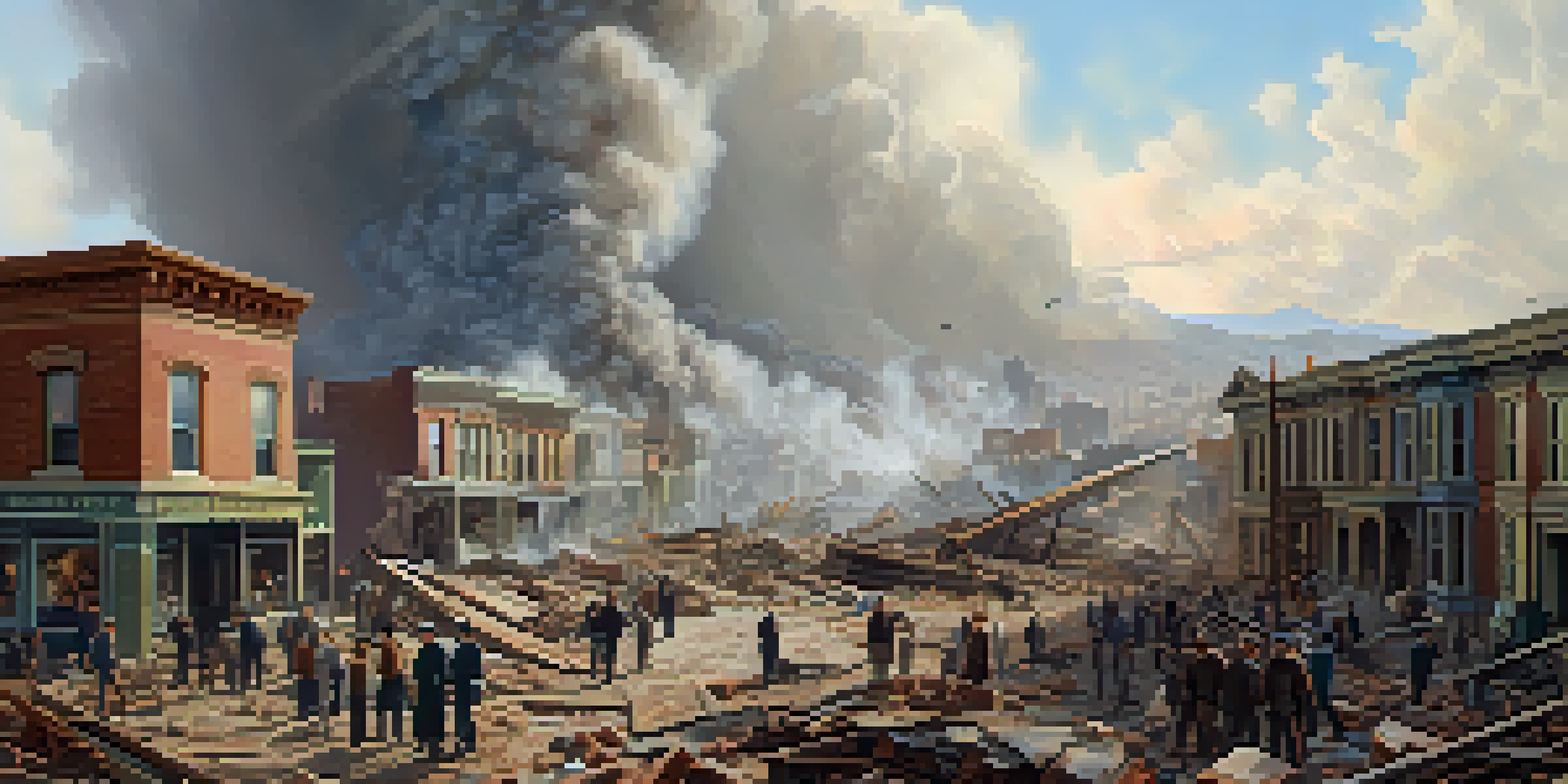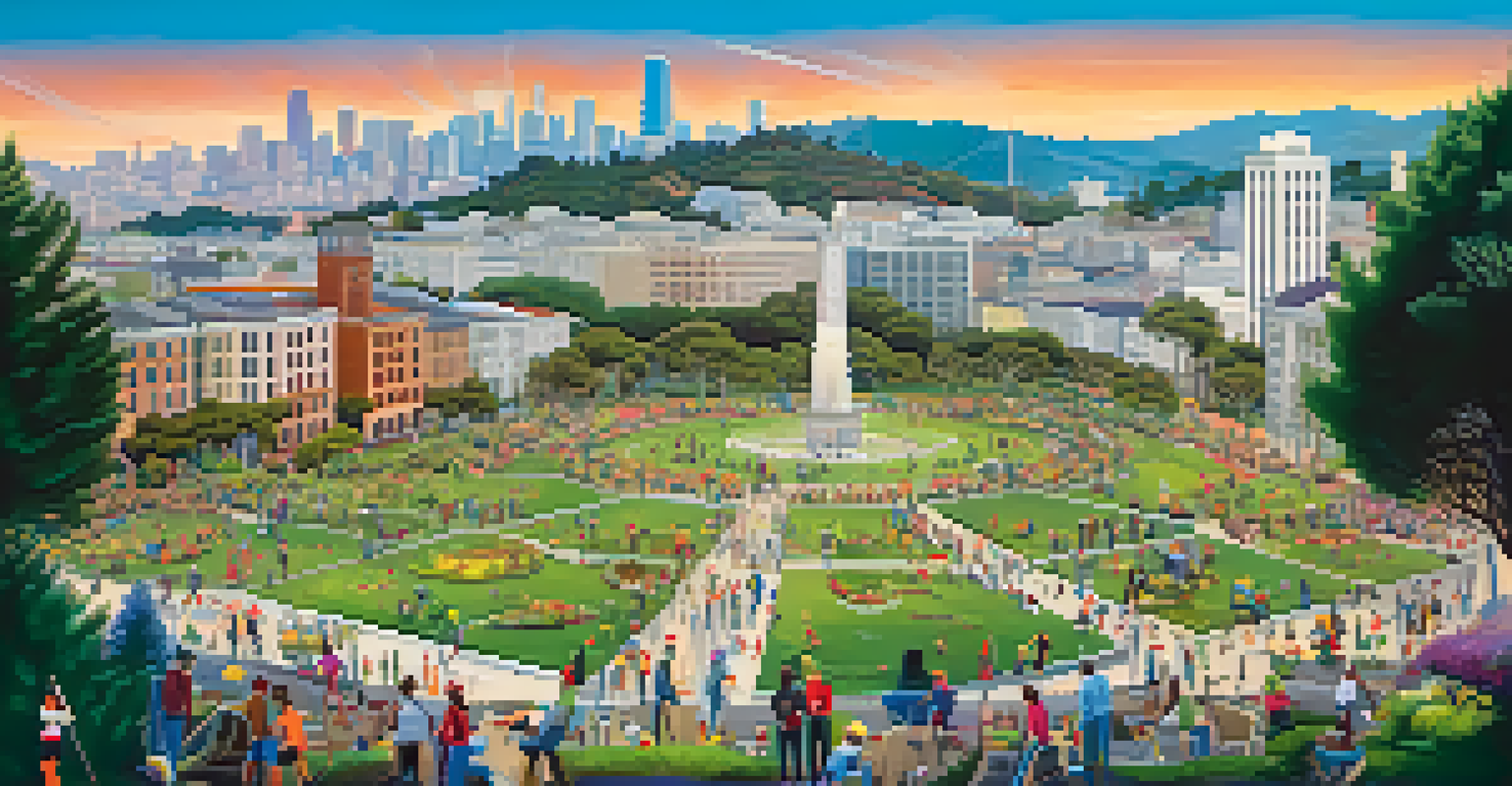The Great Earthquake of 1906: San Francisco's Turning Point

The Earthquake Strikes: A Moment of Catastrophe
On April 18, 1906, at 5:12 AM, a powerful earthquake shook San Francisco, registering a magnitude of 7.9. This sudden jolt was felt across a vast area, leading to widespread panic as buildings trembled and toppled. As residents rushed outside in fear, the ground continued to shake, causing chaos in what was one of the early modern cities of the West Coast.
In the midst of chaos, there is also opportunity.
In the aftermath, the destruction was catastrophic. Over 28,000 buildings were destroyed, leaving thousands homeless. The devastation was not just physical; families were torn apart, and the city’s infrastructure lay in ruins, creating a collective sense of loss and uncertainty.
This earthquake became a pivotal moment for San Francisco, as it not only tested the resilience of its residents but also highlighted the need for better urban planning and disaster preparedness. The immediate response to the disaster set the stage for a transformation that would define the city's future.
The Flames of Destruction: Fire Follows Earthquake
While the earthquake itself was devastating, it was the fires that followed that truly ravaged San Francisco. Within hours of the quake, broken gas lines ignited, leading to infernos that consumed entire neighborhoods. Firefighters were overwhelmed, struggling to contain the raging blazes amid the chaos and destruction caused by the quake.

Over three days, approximately 500 city blocks were engulfed in flames, and it is estimated that around 25,000 people were left homeless as a result. The loss of life was staggering, with the death toll ranging from 3,000 to 6,000, though exact numbers remain elusive due to the nature of the tragedy. This was not just a disaster; it was a human tragedy that left a scar on the city’s collective memory.
Catastrophic Impact of the Earthquake
The 1906 earthquake devastated San Francisco, destroying over 28,000 buildings and leaving thousands homeless.
The fires ultimately changed the landscape of San Francisco, both physically and socially. The destruction created an urgent need for rebuilding, which would lead to innovations in construction and urban design, emphasizing fire safety and resilience against future disasters.
Rescue and Recovery: A Community United
In the wake of the disaster, the spirit of community and resilience emerged as San Francisco rallied together to face the aftermath. Relief efforts sprang into action almost immediately, with volunteers and organizations providing food, shelter, and medical care to those affected. The sense of solidarity was palpable, as neighbors helped neighbors, and strangers became friends.
The greatest glory in living lies not in never falling, but in rising every time we fall.
The federal government also stepped in, as President Theodore Roosevelt dispatched troops to maintain order and provide assistance. The Red Cross, led by Clara Barton, played a crucial role in coordinating relief efforts, distributing supplies, and setting up tent cities for the displaced. This collective response showcased a remarkable level of human compassion and determination.
However, the road to recovery was long and fraught with challenges. The city faced not only the physical task of rebuilding but also the emotional toll on its residents. Yet, through collaboration and grit, San Francisco gradually began to rise from the ashes, setting the foundation for its future growth.
Urban Renewal: Transforming the City Landscape
The destruction caused by the earthquake and subsequent fires prompted a significant urban renewal effort in San Francisco. City planners and architects took this opportunity to rethink the city’s layout and infrastructure, introducing modern building codes and fire safety regulations. This led to the creation of wider streets and the establishment of parks, enhancing the overall livability of the city.
One of the most notable projects was the construction of the iconic Golden Gate Park, which transformed a once-neglected area into a lush green space for the community. The rebuilding efforts also included the development of new neighborhoods that embraced modern design principles, reflecting the spirit of innovation in the early 20th century.
Community Resilience and Recovery
In the face of tragedy, San Francisco's residents united to provide relief and support, showcasing remarkable human compassion.
As the city evolved, the rebuilding process also infused a sense of pride among its residents. San Francisco became a symbol of resilience, showcasing how a community could rise from tragedy and emerge stronger, attracting newcomers and investors eager to be part of its revival.
Lessons Learned: Disaster Preparedness and Response
The Great Earthquake of 1906 taught valuable lessons about disaster preparedness that resonate to this day. In the years following the disaster, San Francisco focused on developing better emergency response systems, including improved communication and coordination among agencies. This proactive approach has become a model for cities worldwide facing similar risks.
Regular drills and public education campaigns were established to ensure that residents understood the importance of being prepared for future earthquakes. Schools began to incorporate safety training into their curriculums, instilling a sense of awareness and responsibility in the younger generation. This shift in mindset was crucial in fostering a culture of preparedness.
Moreover, advancements in seismology and engineering have led to the implementation of technologies designed to minimize damage during earthquakes. Buildings are now constructed with earthquake-resistant designs, reflecting a commitment to safety and resilience. The lessons learned from the 1906 earthquake continue to guide urban planning and disaster management strategies today.
Cultural Impact: The Earthquake in Arts and Literature
The 1906 earthquake left a profound mark on the cultural landscape of San Francisco and beyond. Artists, writers, and filmmakers have drawn inspiration from the disaster, using it as a backdrop to explore themes of loss, resilience, and the human spirit. The earthquake's impact can be seen in various forms of art, from poignant literature to powerful visual representations.
One notable example is the novel 'The San Francisco Earthquake' by author and journalist Frank C. Dyer, which chronicles the events and personal stories of those affected. Additionally, many artists created works that reflected the destruction and hope that emerged in the aftermath, capturing the essence of a city reborn from tragedy.
Urban Renewal and Future Preparedness
The disaster prompted significant urban planning reforms and disaster preparedness initiatives that shaped modern San Francisco.
This cultural reflection serves as a reminder of the power of storytelling and art in processing collective trauma. Through these creative expressions, the legacy of the 1906 earthquake continues to resonate, ensuring that the lessons learned and the spirit of San Francisco are never forgotten.
The Legacy of 1906: Shaping Modern San Francisco
The Great Earthquake of 1906 stands as a defining moment in San Francisco's history, shaping the city into what we know today. The resilience shown by its residents set a precedent for how communities can respond to crises, fostering a deep-rooted sense of unity and strength. This legacy of perseverance continues to inspire new generations of San Franciscans.
Moreover, the rebuilding efforts and urban planning innovations that followed the disaster have made San Francisco a model for disaster preparedness and urban resilience. The city’s commitment to safety, sustainability, and community engagement reflects the lessons learned from its past, ensuring that its future is built on a strong foundation.

As we look back at the events of April 18, 1906, it's clear that while the earthquake brought immense suffering, it also catalyzed a transformation that would propel San Francisco into a new era. Today, the city stands not only as a testament to recovery but as a beacon of hope and innovation in the face of adversity.